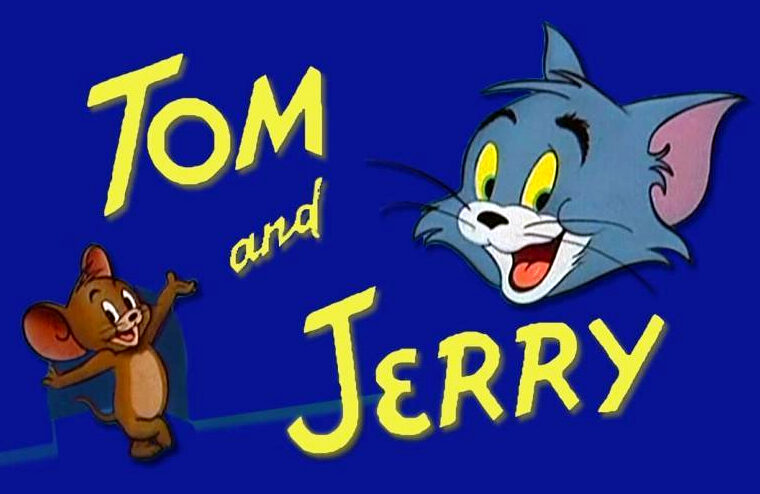William Hanna and Joseph Barbera’s Tom and Jerry cartoons are often dismissed by their critics as horrifically violent slapstick. To their fans, they are hailed as… horrifically violent slapstick. Even by the savage standards of early American animation, the H-B Tom and Jerry shorts were just brutal. They weren’t big on plot, and they didn’t have the vaudevillian wordplay of the Warner Brothers shorts (or any dialogue, for the most part). You could say that these films were built almost entirely around “senseless violence” (as Tom and Jerry director/Hanna-Barbera successor/hater Gene Deitch phrased it), and I wouldn’t completely disagree. I would, however, argue that the Hanna-Barbera Tom and Jerry cartoons were built around the most exquisitely funny, expertly crafted “senseless violence” ever drawn.
Created in 1940, Tom and Jerry stood out from its competitors simply by being the very best at physical comedy. Warner’s Looney Tunes excelled at every style of humor, but no cartoon series could match Hanna-Barbera’s Tom and Jerry when it came to pure slapstick. Characters (usually Tom the Cat) were sliced, smashed, bashed, mashed, electrocuted, mangled, burnt, bruised, beaten, and beyond. It all sounds fairly morbid, but there was just too much good cheer and frenetic energy behind these shorts to be properly mortified. The timing was impeccable, the facial expressions were on point, and the gags were always inventive. When I revisited these cartoons in preparation for this article, I laughed myself silly as if I were watching them for the first time. Those original Tom and Jerry shorts are to cartoon violence what Elvis Presley is to rock.
After Disney’s Steamboat Willie starring Mickey Mouse caused a sensation in 1928, every major studio was trying to create their own Mickey. In the ’30s, MGM experimented with recurring cartoon characters like Flip the Frog and Willie Whopper, but they failed to reach an audience. The studio finally achieved their goal in 1940 when animators Joseph Barbera and William Hanna created a cat-and-mouse duo that would soon conquer animation. That cat and mouse were of course… Jasper and Unnamed Mouse.
Joseph Barbera joined the MGM animation unit in 1937. After working on a failed series based on the Captain and the Kids comic strip, Joseph Barbera teamed up with fellow animator William Hanna to pitch ideas. One such idea was two “equal characters who were always in conflict with each other.” Though Hanna-Barbera considered a fox and dog, they eventually settled on a cat and mouse. The concept was taken to producer/short film department head Fred Quimby, who absolutely did not like the idea. Still, he gave the project the greenlight. Thus, “Puss Gets the Boot” was made.
1940’s “Puss Gets the Boot” was not meant to start a franchise. In fact, Hanna-Barbera was advised by management not to produce any more shorts featuring Jasper the Cat and Unnamed Mouse (he was known as “Jinx” in pre-production, a press release called him “Pee-Wee,” but Joseph Barbera said he had no name in his 1994 autobiography). It was meant to be a one-off frenzy of insane slapstick. However, Texas businesswoman Bessa Short sent a letter to MGM asking if more cat-and-mouse cartoons would be made, convincing MGM to produce more. A studio contest held to rename both characters was won by animator John Carr, who named them after the popular Christmastime cocktail (eggnog with brandy and rum).
“Puss Gets the Boot” was nominated for an Oscar, the first of many nominations and wins for the series. Leonard Maltin described the short as “very new and special […] that was to change the course of MGM cartoon production.” Audiences were just wacky about the pugnacious cat and mouse. With the unprecedented success of “Puss Gets the Boot,” MGM gave the greenlight to an entire run of Tom and Jerry shorts. Hanna-Barbera spent the next 15 years working on the series, resulting in 114 shorts.
Their time with Tom and Jerry was scored by the merrily mad maestro of madcap mayhem, Scott Bradley. Who needed dialogue when you had the greatest zany music ever composed? Bradley’s complex scores incorporated a plethora of styles, including jazz, classical, and the pop of the day. Concertmaster Lou Raderman told Sight & Sound Magazine that “Scott writes the most blank-blank-blank difficult fiddle music in Hollywood … He is going to break my fingers!” Bradley took great pride in his “funny” music, believing that scoring for animation offered more freedom than scoring for live-action. From the very beginning to the very end of Hanna-Barbera’s time with MGM, Bradley’s music played on.
The Academy loved Tom and Jerry as much as they love a lavishly produced period drama. Our psychotic cat-and-mouse duo received 13 Oscar nominations and 7 wins. Yes, Tom and Jerry have more Oscars than Katherine Hepburn. Tom and Jerry won more Academy Awards than any other character-based theatrical animated series. Jerry is undeniably the most Oscar-winning mouse in history. (Sorry, Mickey.)
Like the asteroid that killed the dinosaurs, the rise of television in the 1950s struck the animation industry. Budgets were slashed in half, and the shorts were produced in the widescreen CinemaScope format. However, re-releases of old cartoons were earning as much as the new ones, so MGM shut down its animation department on May 15, 1957. Hanna-Barbera left the studio and created their own company, Hanna-Barbera Productions. Without Tom and Jerry, we wouldn’t have The Flintstones, Yogi Bear, The Jetsons, or Scooby-Doo.
Eventually, Hanna-Barbera reunited with Tom and Jerry. In the ’70s, Hanna-Barbera created “The Tom and Jerry Show” and paired the duo with characters like Grape Ape. That era didn’t recapture the magic of the early years, though it was nice to see Tom and Jerry back with their original creators. Many subsequent animators (including the inimitable Chuck Jones) have made Tom and Jerry cartoons, but you just can’t top perfection. What Hanna-Barbera did in the ’40s/’50s is unsurpassable. “Senseless violence” has never been finer.
- The Phibes Philes: Kongfrontation – Some Thoughts On King Kong Escapes - March 29, 2024
- The Phibes Philes: Robby The Robot –Hollywood’s Automaton Actor - February 29, 2024
- The Phibes Philes: Wonka In Space – The Forgotten “Charlie And The Chocolate Factory” Sequel - January 25, 2024




